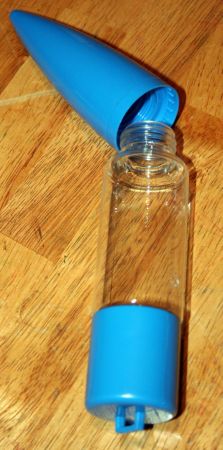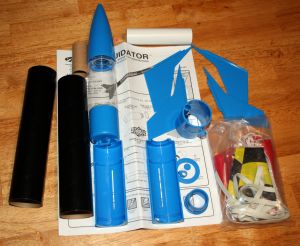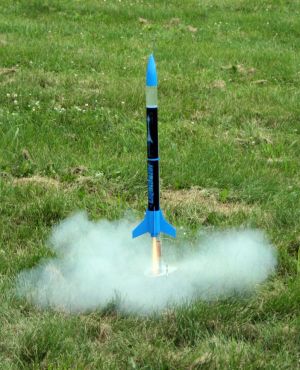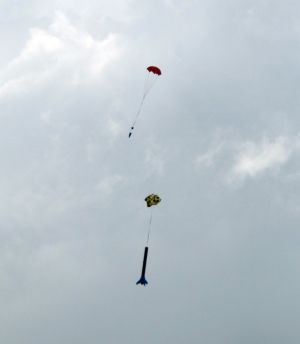| Construction Rating: | starstarstarstarstar_border |
| Flight Rating: | starstarstarstarstar |
| Overall Rating: | starstarstarstarstar_border |
| Diameter: | 1.00 inches |
| Length: | 27.00 inches |
| Manufacturer: | Estes  |
| Skill Level: | 1 |
| Style: | Payload |
Brief:
The Liquidator is a single stage payload rocket with a unique payload section: the payload section is designed to
carry up to four ounces of any type of liquid. My daughters want to shoot a goldfish into space but I think we'll try
some plain water in our initial flights.


Construction:
The Liquidator comes in a hanging bag with a three sided box to protect the rocket components. The components are as
follows: Two black BT-60 body tubes (both 7.5" in length), a EB-1000 engine block, a BT-1000 white engine mount, a
plastic 12" parachute for the rocket body, a 18' nylon parachute for the payload section, two rubber band shock
cords (a 30" cord for the rocket body and a 18" cord for the payload section), and the payload section (which
consists of the clear plastic payload section and a screw on top which also serves as the nosecone of the rocket). The
plastic parts are all royal blue and are as follows: two engine mount 'can' halves, four fins, a tube coupler, a engine
mount centering ring, a launch lug that is fastened to the engine can, and a cap the attaches to the tub coupler to
keep the rocket body shock cord in place.
The instructions for the Estes Liquidator are typical Estes quality, clear and easy to follow. The engine mount is constructed and then mounted inside of the fin can. One potential gotcha is the engine block for this rocket is huge and must fit completely inside of the engine mount tube or the assembly will not fit properly in the can halves. I sanded the block thoroughly so it slid easily inside the engine mount tube before gluing. Since this block is so long, I think it would be a snap to modify this rocket to fit a larger E size engine. By cutting off an inch of the block tube and then securing the block inside the mount tube would allow the E to fit properly. Since an innocent fish's life may hang in the balance, I assembled the rocket for just a D size motor.
 The rest of the assembly is typical E2X: mount the can assembly into one of the body tubes and then
attach the fins and the bottom launch lug. Read the instructions carefully on this step. The launch lug is designed to
fit just one way but could be mounted incorrectly if you don't look at the instruction illustration. Once the bottom
half is assembled, the two body tubes are joined using a plastic tube coupler. The tube coupler has a launch lug
attached and it must be aligned with the bottom launch lug before gluing.
The rest of the assembly is typical E2X: mount the can assembly into one of the body tubes and then
attach the fins and the bottom launch lug. Read the instructions carefully on this step. The launch lug is designed to
fit just one way but could be mounted incorrectly if you don't look at the instruction illustration. Once the bottom
half is assembled, the two body tubes are joined using a plastic tube coupler. The tube coupler has a launch lug
attached and it must be aligned with the bottom launch lug before gluing.
The tube coupler has one trait that I have never seen before in an Estes kit--the parachute shock cord for the rocket body is attached to the tube coupler via a small tube on the inside of the coupler. Once the shock cord is attached, a small plastic cap is glued to the bottom of the small tube to keep the shock cord from falling back into the rocket body. I used a very small amount of glue to attach this cap since it would have to be removed in case the shock cord were to ever need replacing.
Once the body tubes are assembled, the payload section is fitted to the top to complete the assembly.
PROs: Very easy to assembly for the most part. Parts are of high quality.
CONs: Engine block has to be sanded thoroughly to fit properly. Shock cord may be difficult to replace.
Finishing:
Since this is an E2X kit, no painting is required, There are two stick on decals that attach to each of the body
tubes. Since I really hate stick on decals, I took care in placing the stickers to the rocket. The rocket looks very
sharp and the blue and black color scheme looks great.
PROs: No painting, rocket looks great.
CONs: Stick on decals.
Construction Rating: 4 out of 5
Flight:
Readying the rocket for flight has two options for parachute use. If you are going with a non-payload flight, Estes
recommends using just the 12" plastic parachute. Attached the rocket body shock cord to the payload section and
then attach the parachute to the shock cord midway between the nosecone and the rocket body. If you are going to have a
liquid in the payload section, the 12" parachute should be attached to the end of the rocket body shock cord and
the 18" nylon parachute attached to the payload section using the second shock cord. Since I was going to fly with
a payload, I used the second parachute option.
The payload section holds four liquid ounces and for the initial flights, bottled water was used. The nose cone screwed tightly to the payload section and no leakage occurred. Once loaded with liquid this bird is heavy! The rocket weighs 5.7 ounces empty and the water adds another 4.2 ounces of weight bring the total to near ten ounces.
For the first flights I used D12-5 engines on all three flights. The engines are secured with one of the twist-on end caps Estes uses with many of their E2X kits. Dog barf was used for protecting the parachutes. Flight day was sunny and there was very little wind.
The rocket lifted slowly from the pad, arrow straight flight to about four hundred feet. At apogee the rocket tipped downward very quickly due to the weight. Rocket was pointed downwards when the parachutes deployed. The payload section and its nylon parachute cleared the rocket body cleanly and both the rocket body and payload parachutes opened fully. Both sections landed around a hundred feet from the pad.
A D12-3 motor may be a better fit for this rocket than the D12-5, eliminating some of that delay as the rocket falls straight down to the earth. Even with the longer delay, the rocket had enough time for the parachutes to deploy and recover cleanly.
The next two flights were mirrors of the first: straight up and clean deployments, landing fairly close to the pad.


Recovery:
Both sections landed with no damage. The nylon parachute held the payload section up nicely with soft landings. The
payload did not leak a drop. Rocket body was recovered with no damage to the body or the parachute.
Flight Rating: 5 out of 5
Summary:
The Estes Liquidator does what it claims to do. It lifts four ounces of water into 'space' and allows for a great
recovery. While this rocket will never break any altitude records for flight, it does fly straight and true on its
recommended motors. The payload section is designed nicely, holding its liquid cargo intact through both flight and
recovery.
Overall Rating: 4 out of 5
 |
 |
Flights
 |
 |
Sponsored Ads
 |
 |












J.E. (August 2, 2009)